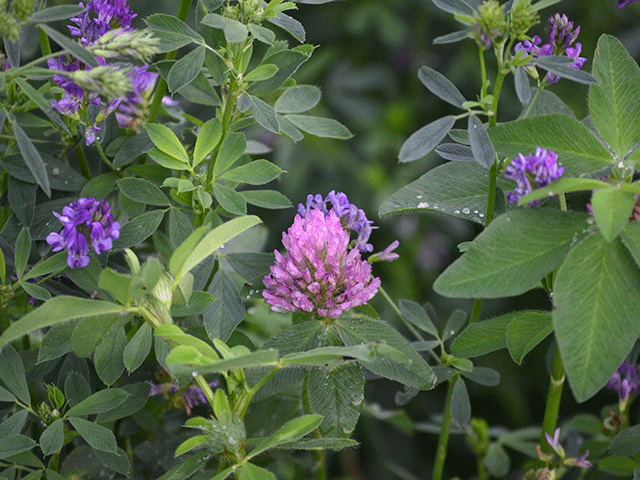Look Out for Alfalfa Pests, Diseases
Several Alfalfa Insects, Ailments Rob Yield, Lower Crop Quality
OMAHA (DTN) -- Recognizing insect pests and diseases in alfalfa can help producers know what management practices should be utilized to limit crop damage. An important aspect of identifying pests would be to scout the crop during the growing season.
In a South Dakota State University (SDSU) Extension Crop Hour webinar on forages, SDSU experts weighed in on what insect pests and diseases are common in alfalfa (https://www.youtube.com/…). In addition, they also recommended what steps should be taken once the pests or diseases are found in the field.
MANY ALFALFA PESTS
The most common insect pest found in alfalfa would be the alfalfa weevil, according to Patrick Wagner, SDSU Extension entomology field specialist. Larvae feed on terminal buds and new leaves, which can affect first cutting and later cuttings.
The economic threshold would be two larvae per stem or 30% to 40% of leaf tips damaged, he said. The best management practice would be early harvest, a foliar insecticide application or even graze livestock in the fall to limit the insect.
Potato leafhoppers are another insect that feeds on alfalfa. Both adults and nymphs of this pest cause plant injury; that injury results in losses to yield and quality of the alfalfa crop, he said.
Fields should be scouted after the first cutting and economic threshold depends on the height of the alfalfa. The taller the crop is the more vulnerable it is to pests (https://ipcm.wisc.edu/…).
"Harvesting alfalfa in the bud stage as well as applying foliar insecticides would be effective potato leafhopper management," Wagner said.
Aphids also can cause much damage to alfalfa. Among the aphids found in South Dakota that affect alfalfa are pea aphids, spotted alfalfa aphids, blue alfalfa aphids and cowpea aphids.
Wagner said aphids in large populations can reduce yields, while the crop can tolerate lower populations of aphids. As with other insect pests, early harvest and an insecticide application can limit crop damage.
Other pests that should be watched in alfalfa are plant bugs, grasshoppers, army cutworm, variegated cutworm and dingy cutworm.
BLISTER BEETLE: TOXIC PEST
P[L1] D[0x0] M[300x250] OOP[F] ADUNIT[] T[]
An insect pest that produces a toxin and can kill livestock at high infestation levels is the blister beetle. This pest is normally not a huge problem, but producers should be aware of the insect and be able to scout their fields.
Wagner said blister beetles are up to an inch long and their color varies from gray, black or even striped. The beetles are attracted to alfalfa blossoms and the pests contain a chemical called cantharidin, which causes blisters.
The chemical is released if the beetles are crushed and can contaminate the hay, he said. This contaminated hay, if fed to livestock can be fatal, especially to horses.
Wagner said if you suspect you have blister beetles, check fields prior to each cutting, although later cuttings are at higher risk of infestations. The pest can be scouted with visual observations, although sweep nets are useful.
While producers' first instinct would to be spray fields infested with blister beetles, this is not the most efficient way to control them. In fact, you may even increase the number of beetles per bale, he said.
Management practices would be to harvest alfalfa prior to peak bloom and allow the cutting of hay to fully dry before raking.
"Cut hay without using a conditioner, since you don't crimp or crush the hay, you will not be crushing the beetles either," he said.
If you suspect your hay may have blister beetles, Wagner said notify buyers if you are selling hay.
Those who are feeding the hay to horses should only feed first cutting, he said. Also avoid feeding hay cut around the edges of the field as blister beetle populations are higher in these areas.
LOOK FOR ALFALFA DISEASES
Alfalfa diseases can also cause injuries to plants, lower yields and affect the quality of alfalfa. Emmanuel Byamukama, SDSU Extension plant pathologist, said the most common alfalfa disease is alfalfa rust.
The rust develops under cool, wet weather in the fall. If enough rust is present, yields and quality can be affected.
If the alfalfa stand is a new crop, Byamukama said a fungicide application may be necessary. Otherwise simply scouting and cutting early before leaves drop would be a good management practice.
Spring black stem and leaf spot and summer black stem and leaf spot are a couple more alfalfa diseases. These diseases are caused by different pathogens, he said.
Spring black stem and leaf spot like cooler, wet weather (under 70 degrees Fahrenheit) while summer black stem and leaf spot likes warmer, wet weather (around 79 F). The spring version is usually more severe at first cutting while the summer disease is more severe with the later cuttings, he said.
"Scout and cut alfalfa early to avoid leaf drop and a fungicide may be needed for the summer black stem and leaf spot," Byamukama said.
WATCH FOR AMV
Another common virus in alfalfa fields is alfalfa mosaic virus (AMV), according to Connie Strunk, SDSU Extension plant pathology field specialist.
This virus is transmitted by different types of aphids, although the most common aphid in South Dakota is pea aphids, she said. AMV overwinters in alfalfa crown roots and new growth in the spring has leaves with yellow and green mosaic patterns.
Symptoms can differ with the age of the plants and with different weather patterns, she said. Infected plants have reduced vigor and alfalfa stands infected with AMV will see stand declines.
Strunk said there is no rescue treatments available once symptoms are evident. For new plantings, select alfalfa cultivars that have resistance to AMV, she said.
Proactive broadleaf weed management, especially scouting for broadleaf weeds, could limit the instances of AMV. Black nightshade can be a good source for AMV, she said.
"Scout for aphid population and manage them early to prevent additional spread of AMV within the field," Strunk said.
Russ Quinn can be reached at russ.quinn@dtn.com
Follow him on Twitter @RussQuinnDTN
(c) Copyright 2021 DTN, LLC. All rights reserved.






